From the Editor – January 2026
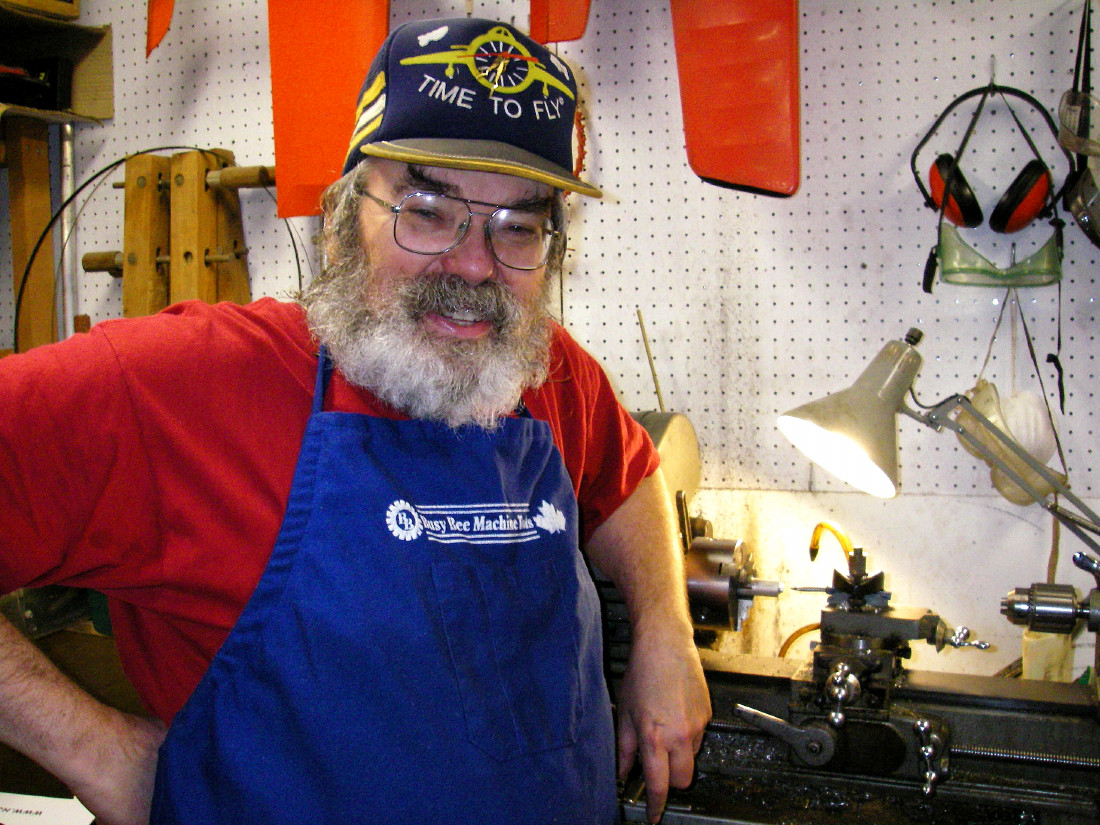 Greetings once more to one and all! First, please allow me to express the hope that you’ve all enjoyed a rewarding holiday season with friends and family, and to extend my sincere wish to you all for as happy and prosperous a New Year as present circumstances permit. I hope that Santa was able to complete his rounds by visiting your area before Agent Orange (AO) was able to execute his plan to annex the North Pole, demolish the workshop to build a ballroom, turn the reindeer into steaks for his next Great Gatsby party and turn Santa, Mrs. Claus and the elves over to the tender mercies of ICE! The inmates appear to be running the asylum at present, and we can only hope for an eventual return to global sanity at some point down the road. Meanwhile, let’s all do our best to get the most of what life has to offer!
Greetings once more to one and all! First, please allow me to express the hope that you’ve all enjoyed a rewarding holiday season with friends and family, and to extend my sincere wish to you all for as happy and prosperous a New Year as present circumstances permit. I hope that Santa was able to complete his rounds by visiting your area before Agent Orange (AO) was able to execute his plan to annex the North Pole, demolish the workshop to build a ballroom, turn the reindeer into steaks for his next Great Gatsby party and turn Santa, Mrs. Claus and the elves over to the tender mercies of ICE! The inmates appear to be running the asylum at present, and we can only hope for an eventual return to global sanity at some point down the road. Meanwhile, let’s all do our best to get the most of what life has to offer!
My recovery from the removal of my stomach tumor followed by my gall bladder continues to go well, with no significant side effects so far and no evidence of a relapse. Still no progress to report regarding my incisional hernia - I’m still waiting to hear from the surgeon to whom my case was very belatedly referred by my namesake surgeon Dr. Duncan. It appears that my case is not viewed as serious because it doesn't prevent me from carrying on with many of my usual activities. Oh well, I hope eventually to receive proof that all things come to him who waits!
 Next, the bad news! Down south, the incomprehensible election of a convicted felon, self-labeled ego-maniac, supporter of criminals, repeatedly-proven liar and enthusiastic associate of sex criminals to the Presidency continues to play out predictably through the process of steady erosion of the democratic rights and freedoms of the citizens of the US (seemingly with the inexplicable acquiescence of far too many of them) and the downgrading of the USA’s perceived status among the international community to the point where it’s no longer generally recognized as a “free democracy”, having been downgraded to a “flawed democracy” under the internationally-respected Economist Democracy Index and already being well on its way down to the next levels - “hybrid regime” (routine electoral fraud and weak rule of law), closely followed by “authoritarian regime”.
Next, the bad news! Down south, the incomprehensible election of a convicted felon, self-labeled ego-maniac, supporter of criminals, repeatedly-proven liar and enthusiastic associate of sex criminals to the Presidency continues to play out predictably through the process of steady erosion of the democratic rights and freedoms of the citizens of the US (seemingly with the inexplicable acquiescence of far too many of them) and the downgrading of the USA’s perceived status among the international community to the point where it’s no longer generally recognized as a “free democracy”, having been downgraded to a “flawed democracy” under the internationally-respected Economist Democracy Index and already being well on its way down to the next levels - “hybrid regime” (routine electoral fraud and weak rule of law), closely followed by “authoritarian regime”.
 Agent Orange (AO) was elected to the office of President, but has yet to commence serving as such. He’s evidently too simple-minded to grasp the concept that to be the President, you have to act like the President, which among other things means serving the entire US population (not merely the MAGGATS) and advocating adherence to the Constitution rather than progressively ripping it up.
Agent Orange (AO) was elected to the office of President, but has yet to commence serving as such. He’s evidently too simple-minded to grasp the concept that to be the President, you have to act like the President, which among other things means serving the entire US population (not merely the MAGGATS) and advocating adherence to the Constitution rather than progressively ripping it up.
Among his more disturbing actions recently has been his significant restriction of vaccination in America. How many US kids will die as a result of this incredible folly? Each preventable death will make him a murderer. His proposed new rules requiring visitors to the USA to completely expose their private lives to total strangers at the border, mirroring the situation during the  McCarthy era of the 1950’s, is nothing short of a gross invasion of privacy which together with his US Park user fees for visiting tourists will have the inevitable effect of further discouraging visitation to the USA, to the great detriment of the already hard-hit US tourism industry. His proposal to block any US State from enacting regulations governing the application of Artificial Intelligence (AI) demonstrates a frightening lack of understanding of the well-documented and very real threats to society which unrestricted AI unquestionably represents. His ongoing inane attempts to blame his predecessor for his own failures are becoming tiresome, even to some of his own supporters. Finally, his truly shameful (and barely coherent) comments on the deaths of Rob Reiner and his wife establish a new all-time low in terms of Presidential disrespect of the citizens of his own country whom he was elected to serve. So do his hate-filled 2025 “Christmas messages”……….
McCarthy era of the 1950’s, is nothing short of a gross invasion of privacy which together with his US Park user fees for visiting tourists will have the inevitable effect of further discouraging visitation to the USA, to the great detriment of the already hard-hit US tourism industry. His proposal to block any US State from enacting regulations governing the application of Artificial Intelligence (AI) demonstrates a frightening lack of understanding of the well-documented and very real threats to society which unrestricted AI unquestionably represents. His ongoing inane attempts to blame his predecessor for his own failures are becoming tiresome, even to some of his own supporters. Finally, his truly shameful (and barely coherent) comments on the deaths of Rob Reiner and his wife establish a new all-time low in terms of Presidential disrespect of the citizens of his own country whom he was elected to serve. So do his hate-filled 2025 “Christmas messages”……….
 Among the more reprehensible actions undertaken recently by AO are his multiple seizures of oil tankers on the high seas and the statement that America will keep the oil. Whatever the reason for these actions, the outright theft of the oil from whoever owns it makes this piracy, pure and simple. Has he been watching “Treasure Island”, “Hook” or “Pirates of the Caribbean” - is he having Jack Sparrow delusions or something? Based on talent, Johnny Depp has nothing to worry about! Regardless, America is now a nation which officially endorses and profits from piracy on the high seas. Shameful …………….
Among the more reprehensible actions undertaken recently by AO are his multiple seizures of oil tankers on the high seas and the statement that America will keep the oil. Whatever the reason for these actions, the outright theft of the oil from whoever owns it makes this piracy, pure and simple. Has he been watching “Treasure Island”, “Hook” or “Pirates of the Caribbean” - is he having Jack Sparrow delusions or something? Based on talent, Johnny Depp has nothing to worry about! Regardless, America is now a nation which officially endorses and profits from piracy on the high seas. Shameful …………….
 Looking on the bright side, AO has at least given us all our laugh for the month! His acceptance of the meaningless “Peace Prize” cobbled up by his buddy Gianni Infantino, the President of the world soccer governing body FIFA, exposes to one and all his immaturity, childish sense of insecurity and openness to flights of narcissistic fantasy. This “award” was created for AO simply because he was so vociferously upset at not being awarded a legitimate Peace Prize by the appropriate authorities despite his very active lobbying. When his juvenile tantrums came to the attention of his mate Gianni, the response was to assuage the child’s hurt feelings by creating an “award” especially for him – this from an organization whose business is supposedly soccer, not international diplomacy on a broader scale.
Looking on the bright side, AO has at least given us all our laugh for the month! His acceptance of the meaningless “Peace Prize” cobbled up by his buddy Gianni Infantino, the President of the world soccer governing body FIFA, exposes to one and all his immaturity, childish sense of insecurity and openness to flights of narcissistic fantasy. This “award” was created for AO simply because he was so vociferously upset at not being awarded a legitimate Peace Prize by the appropriate authorities despite his very active lobbying. When his juvenile tantrums came to the attention of his mate Gianni, the response was to assuage the child’s hurt feelings by creating an “award” especially for him – this from an organization whose business is supposedly soccer, not international diplomacy on a broader scale.
 AO’s acceptance of this “award” clearly implies that he actually sees it as legitimate, thus demonstrating once again his total lack of any sense of propriety or recognition of reality and making both AO and Infantino international laughing stocks – Infantino presenting a placebo for a baby’s dummy to Infantilo, which both see as being meaningful! I suppose that in one sense they are ………. the sight of the world’s most corrupt sporting organization honoring the world's most corrupt “official” does make a certain amount of sense, since the two go together like a proffered bribe bag and a grasping outstretched hand. Why would AO expect to win a real peace prize when he’s dedicated his political life to tearing his own country apart, conducting military occupations of American cities, preaching hate and division against the Democrats who represent half of the entire US population that he was elected to serve, indulging in piracy on the high seas, launching military strikes upon other countries with whom war has not been declared, supporting genocide in Gaza and threatening hitherto allied nations with unprovoked military annexation of part or all of their territory? Given these indisputable facts, what does he think that the FIFA “award” proves?!? Or does he think at all …..??
AO’s acceptance of this “award” clearly implies that he actually sees it as legitimate, thus demonstrating once again his total lack of any sense of propriety or recognition of reality and making both AO and Infantino international laughing stocks – Infantino presenting a placebo for a baby’s dummy to Infantilo, which both see as being meaningful! I suppose that in one sense they are ………. the sight of the world’s most corrupt sporting organization honoring the world's most corrupt “official” does make a certain amount of sense, since the two go together like a proffered bribe bag and a grasping outstretched hand. Why would AO expect to win a real peace prize when he’s dedicated his political life to tearing his own country apart, conducting military occupations of American cities, preaching hate and division against the Democrats who represent half of the entire US population that he was elected to serve, indulging in piracy on the high seas, launching military strikes upon other countries with whom war has not been declared, supporting genocide in Gaza and threatening hitherto allied nations with unprovoked military annexation of part or all of their territory? Given these indisputable facts, what does he think that the FIFA “award” proves?!? Or does he think at all …..??
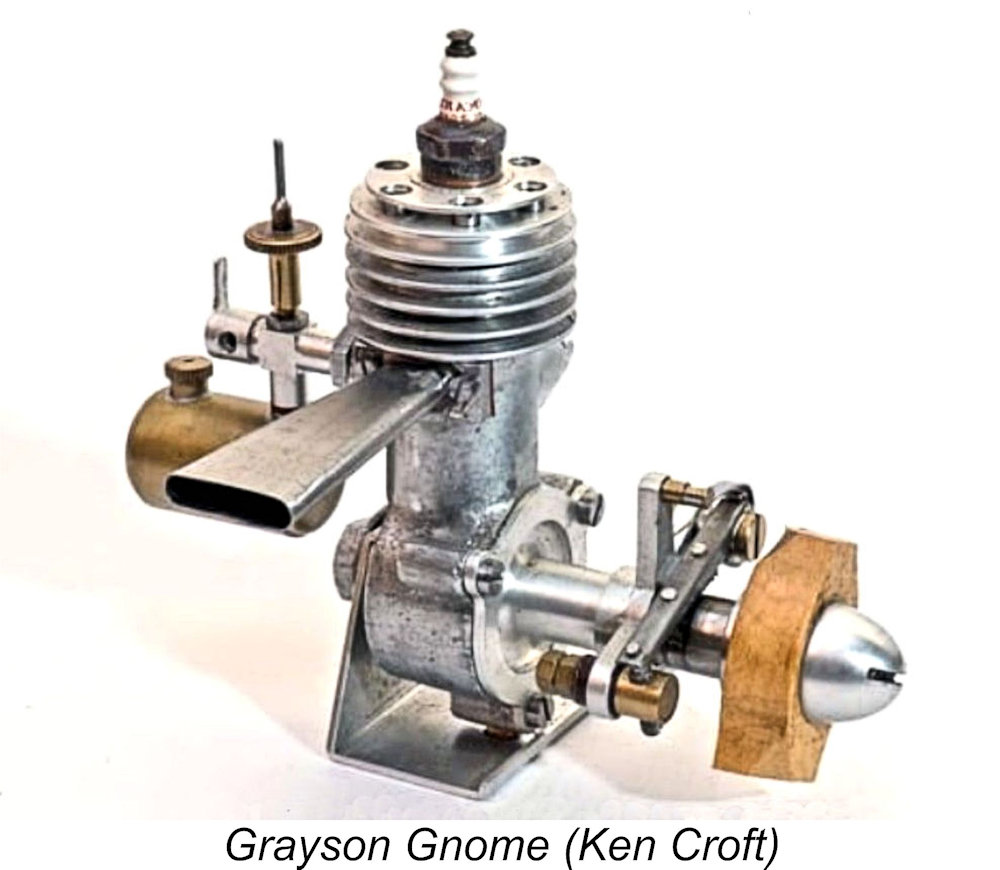 Returning thankfully to reality, I’m always very pleased to hear from readers that they have found my articles to be interesting or useful. It’s that kind of feedback that keeps me going! However, my favourite reader reaction to my efforts is the provision of details and information sources which I’ve missed first time around.
Returning thankfully to reality, I’m always very pleased to hear from readers that they have found my articles to be interesting or useful. It’s that kind of feedback that keeps me going! However, my favourite reader reaction to my efforts is the provision of details and information sources which I’ve missed first time around.
In that context, I received an unusually large amount of new material in connection with last month’s article on the Grayson engines. My valued friends and colleagues Gordon Beeby, Maris Dislers and Marcus Tidmarsh were all able to supply details which were new to me and which warranted a major re-write of the article. This re-write was sufficiently extensive to prompt me to recommend that anyone interested in the Grayson engines go back and read the article again – it is now considerably more comprehensive. My very sincere thanks to the listed informants who made this possible!
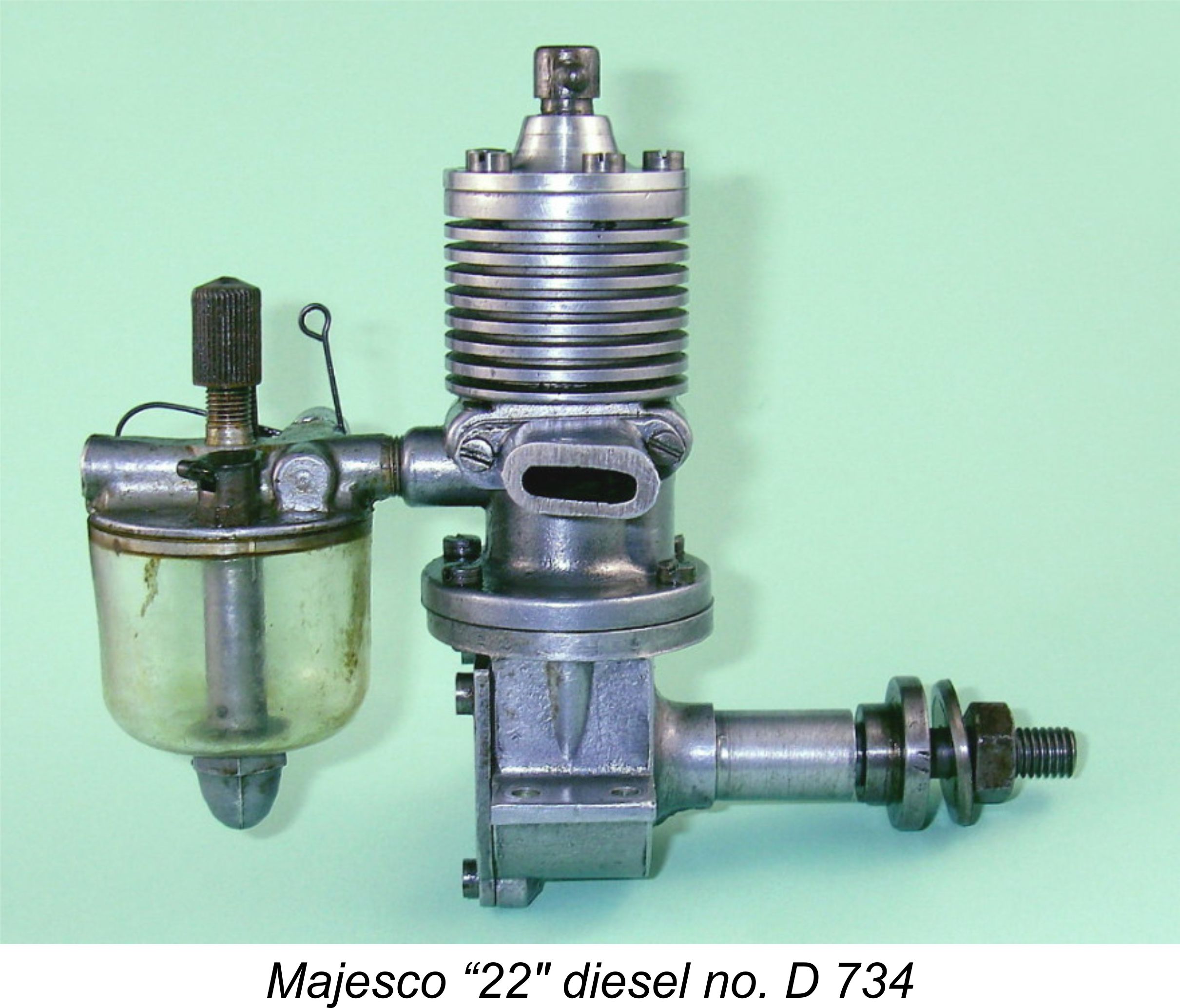 In this vein, the aforementioned Gordon Beeby of Australia has become one of my most active assistants, developing an uncanny knack for ferreting out obscure information sources relating to various articles. His latest tour de force is a search for information on the Majesco engines which were the subject of an article which I published here some time ago. Gordon was successful in finding a number of highly illuminating references which have enabled me to improve both the scope and authoritativeness of that article considerably. In particular, I’ve been enabled to document the pre-WW2 activities of Majesco manufacturer Jack Colyer to a remarkable level of detail, including a hitherto-unrecognized pre-Majesco connection with model engine manufacture. If the Majesco range commands your interest, it’s well worth re-visiting the revised article to sample the broader coverage to be found there now. Thanks, Gordon!
In this vein, the aforementioned Gordon Beeby of Australia has become one of my most active assistants, developing an uncanny knack for ferreting out obscure information sources relating to various articles. His latest tour de force is a search for information on the Majesco engines which were the subject of an article which I published here some time ago. Gordon was successful in finding a number of highly illuminating references which have enabled me to improve both the scope and authoritativeness of that article considerably. In particular, I’ve been enabled to document the pre-WW2 activities of Majesco manufacturer Jack Colyer to a remarkable level of detail, including a hitherto-unrecognized pre-Majesco connection with model engine manufacture. If the Majesco range commands your interest, it’s well worth re-visiting the revised article to sample the broader coverage to be found there now. Thanks, Gordon!
I’ve often had occasion to comment on the fact that far too many previous writers have tended to simply repeat the assertions of their predecessors rather than go back to original contemporary sources to ground-check previous statements. This has led to a distressing amount of misinformation being perpetuated over the years. I’ve always tried very hard to avoid falling into that trap myself. Both Gordon and I have been quite astonished to discover how much information is actually out there if you take the trouble to look – it’s just a matter of spending time tracking it down! Too many previous writers haven’t bothered to do so, and Gordon’s assistance to me in this regard has been quite invaluable – I do what I can, but I simply don’t have the time to do it all myself!
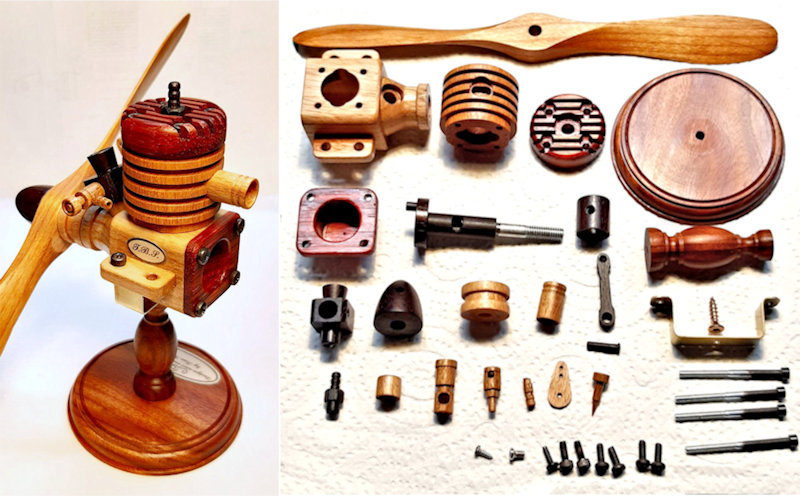 An unexpected but very welcome contact came from reader Tom Biesot of the Netherlands. In addition to being an engine collector who carries out his own restorations, Tom is also an amazingly accomplished precision woodworker. In that context, he sent some images of one of his latest creations - a complete model engine made entirely out of wood! Setting aside the materials used, this is a fully functional model engine! It is constructed from a variety of wood species, including beech, rosewood (dark), red alder (propellor), teak and ash. Think of it – wood lathes don’t have vernier top-slides or leadscrews: it’s all down to a steady hand! Tom put around 150 hours into the design and construction of this remarkable creation, which now graces his desktop! Amazing ..................
An unexpected but very welcome contact came from reader Tom Biesot of the Netherlands. In addition to being an engine collector who carries out his own restorations, Tom is also an amazingly accomplished precision woodworker. In that context, he sent some images of one of his latest creations - a complete model engine made entirely out of wood! Setting aside the materials used, this is a fully functional model engine! It is constructed from a variety of wood species, including beech, rosewood (dark), red alder (propellor), teak and ash. Think of it – wood lathes don’t have vernier top-slides or leadscrews: it’s all down to a steady hand! Tom put around 150 hours into the design and construction of this remarkable creation, which now graces his desktop! Amazing ..................
 Tom also sent me a Christmas card of his own creation. Although we’re now past Christmas, I thought that this card was far too nice not to share with you all! It displays Santa Cox in his sleigh drawn by his seven Cox reindeer! Note that Rudolph is a Tee-Deer!
Tom also sent me a Christmas card of his own creation. Although we’re now past Christmas, I thought that this card was far too nice not to share with you all! It displays Santa Cox in his sleigh drawn by his seven Cox reindeer! Note that Rudolph is a Tee-Deer!
Another contact from the Netherlands came from my good mate Peter Valicek, who sent along some details of a very cute little diesel which he recently received from a Scottish friend as a gift. This little gem has measured bore and stroke dimensions of 8.04 mm and 11.07 respectively – probably nominally designed as 8 mm and 11 mm respectively for a nominal displacement of 0.55 cc. It weighs 55 gm complete with its radial mounting bracket.
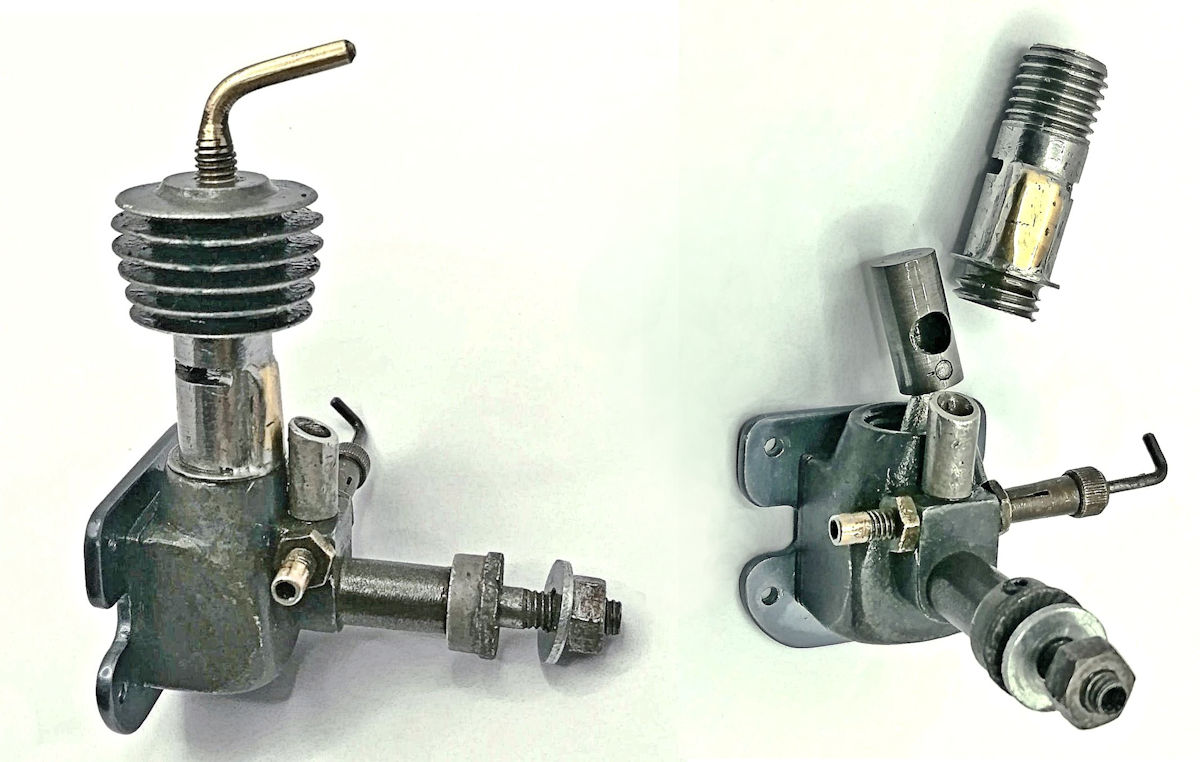 All threads are BA standard, indicating a British origin. The piston and cylinder of this engine bear an unmistakable resemblance to those of the Kemp Hawk Mk. I – the piston-ported bypass and unusually low wrist pin location are particularly distinctive. The engine is constructed entirely from magnesium alloy castings. This leads me to speculate that this may be a one-off prototype made by Harold Kemp, who is known to have used magnesium castings during his first year or two. However, that speculation can’t be proved. All that Peter can tell us is that the engine is extremely well-made and runs very well indeed! Any ideas out there?!?
All threads are BA standard, indicating a British origin. The piston and cylinder of this engine bear an unmistakable resemblance to those of the Kemp Hawk Mk. I – the piston-ported bypass and unusually low wrist pin location are particularly distinctive. The engine is constructed entirely from magnesium alloy castings. This leads me to speculate that this may be a one-off prototype made by Harold Kemp, who is known to have used magnesium castings during his first year or two. However, that speculation can’t be proved. All that Peter can tell us is that the engine is extremely well-made and runs very well indeed! Any ideas out there?!?
Still speaking of Wotizits, reader David Hill wrote in to advise that he had a 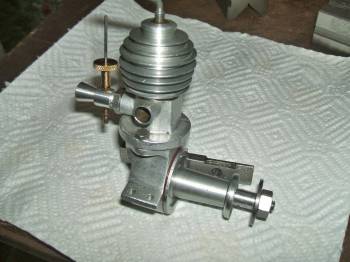 near-duplicate of the 3.2 cc Czech (?!?) diesel which appeared some time ago in my Wotizit pages (left). I’ve added David’s details to the relevant entry. The main takeaway here is that this engine isn’t just a “one-off” - multiple examples were evidently made. However, we still don’t have any information regarding the origin of this engine – can anyone out there help?
near-duplicate of the 3.2 cc Czech (?!?) diesel which appeared some time ago in my Wotizit pages (left). I’ve added David’s details to the relevant entry. The main takeaway here is that this engine isn’t just a “one-off” - multiple examples were evidently made. However, we still don’t have any information regarding the origin of this engine – can anyone out there help?
This reinforces a comment which I’ve made previously – I strongly urge all of my readers to review the Wotizit pages on a regular basis. Everyone’s knowledge and experience are always changing, and new insights may result, possibly leading to further enlightening comments like those of David.
One slightly sour note that didn’t enhance my 2025 holiday season arose from my web search for additional information on a previously-covered topic that I was revisiting purely to see if an update was warranted. I came across a comment from an individual who shall remain nameless (but I’m sure that he knows who he is!) who responded on a public forum to requests from others for information on the same topic. He presented himself as knowing a good deal about the topic and proceeded to provide some very useful information in the manner of a guru imparting knowledge to his disciples from the mountaintop. Fair enough, but he actually went so far as to phrase his comments in terms which made it clear that his information source was this website! Some of his statements were a straight cut-and-paste job – I saw my own words!! However, there was no acknowledgement and no referral to this website for further information.
Now I don’t mind people passing along the information that is presented here – far from it! The more widely disseminated the information is, the better it will be for our hobby. All that I’ve ever asked (as I do with every new editorial) is that references to my work be acknowledged! This wish is not motivated by any craving on my part for kudos – I’m not AO!! Rather, it’s to encourage an ever-larger readership for my efforts purely in order to strengthen our hobby through the creation of a more globally distributed and better-informed participant group. Many of those who provide comments to others (including some eBay sellers) do refer their readers to this site as a source of more detailed information – that’s all I ask in return for the very considerble outlay of time and money required to maintain and expand this website (the contents of which are made free to all). Most of you respect my wishes in this regard, for which I’m grateful – all I ask is that you all do so!!
 OK, on to the new articles for this month! Despite the continuing pressures resulting from the highly charged international situation in which we find ourselves, I’ve somehow managed once again to assemble what I hope will be another interesting selection of articles for your reading pleasure. Moreover, I’ve had help!
OK, on to the new articles for this month! Despite the continuing pressures resulting from the highly charged international situation in which we find ourselves, I’ve somehow managed once again to assemble what I hope will be another interesting selection of articles for your reading pleasure. Moreover, I’ve had help!
The first new article deals with a somewhat obscure but nonetheless significant model engine range from behind the Iron Curtain in what was then East Germany. This is the series of engines (predominantly diesels) designed by Wilhelm (“Willi”) Otto and manufactured from 1943 until 1966 under the Wilo trade-name derived from that of Otto himself. Willi Otto was one of the pioneers of model diesel development in Germany, producing a number of very interesting designs. The fact that his Wilo engines were never seriously marketed on the Western side of the Iron Curtain has led to their comparative neglect among today’s model engine aficionados. Time to set that straight!
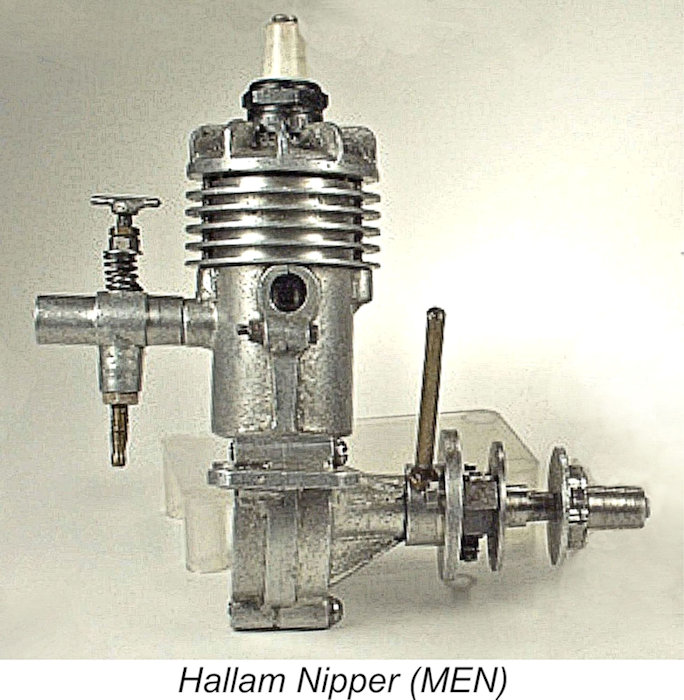 I already mentioned last month’s article about the pioneering Grayson range from 1930’s London, England. I indicated that this would be the first of a series of articles about the various British model engine ranges of the pre-WW2 pioneering era. American engines from this era have received extensive coverage in the past, but their British counterparts have been comparatively neglected. This is an imbalance that should be set right!
I already mentioned last month’s article about the pioneering Grayson range from 1930’s London, England. I indicated that this would be the first of a series of articles about the various British model engine ranges of the pre-WW2 pioneering era. American engines from this era have received extensive coverage in the past, but their British counterparts have been comparatively neglected. This is an imbalance that should be set right!
Accordingly, as my next contribution to the documentation of these engines I’ve prepared an article tracing the story of the Hallam range from Upton near Poole, Dorset. This range was surprisingly diverse, including both four-stroke and two-stroke spark ignition models in a wide range of displacements as well as a single diesel. Their market tenure too was remarkably long, covering some two decades from 1930 to 1950, making their comparative neglect all the more unwarranted. It’s an interesting story which I suspect will surprise many readers!
 I mentioned earlier that I had help this time around. My good mate Maris Dislers has contributed an unsolicited review and test of the CS-manufactured 0.48 cc Clanford Clan diesel. Very informative! I’ve added this material to Maris’s existing article on the original 0.24 cc Clanford Clan which may be found on this website. Thanks, mate!
I mentioned earlier that I had help this time around. My good mate Maris Dislers has contributed an unsolicited review and test of the CS-manufactured 0.48 cc Clanford Clan diesel. Very informative! I’ve added this material to Maris’s existing article on the original 0.24 cc Clanford Clan which may be found on this website. Thanks, mate!
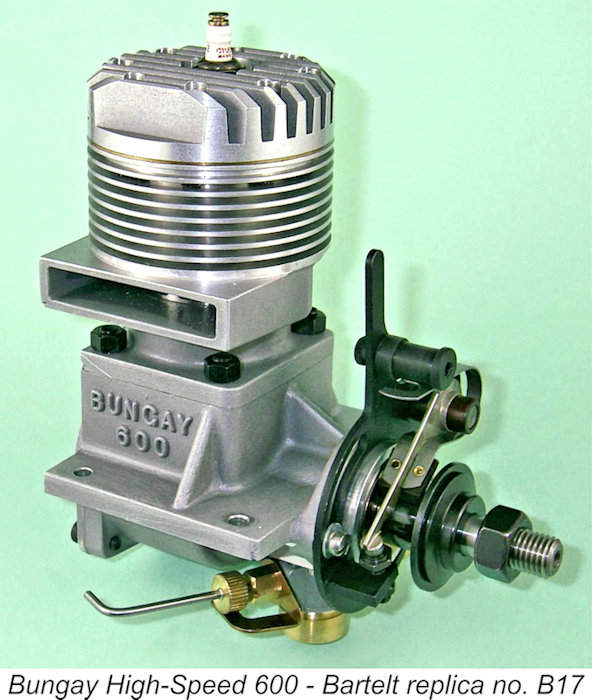 The MEN transfer article for the month deals with one of my own favourite facets of model engine design – the classic racing engine. This article deals with a very rare 10 cc model called the Bungay Hi-Speed 600 which was manufactured in relatively small numbers in New York City during 1948. It is most notable for having been the final attempt by any classic-era manufacturer to challenge the dominant RRV racing designs such as the Dooling 61 and McCoy 60 Series 20 with an FRV design. Unfortunately, its challenge fell somewhat short, resulting in its very brief market tenure. Still, it was a fascinating design which is well worth remembering!
The MEN transfer article for the month deals with one of my own favourite facets of model engine design – the classic racing engine. This article deals with a very rare 10 cc model called the Bungay Hi-Speed 600 which was manufactured in relatively small numbers in New York City during 1948. It is most notable for having been the final attempt by any classic-era manufacturer to challenge the dominant RRV racing designs such as the Dooling 61 and McCoy 60 Series 20 with an FRV design. Unfortunately, its challenge fell somewhat short, resulting in its very brief market tenure. Still, it was a fascinating design which is well worth remembering!
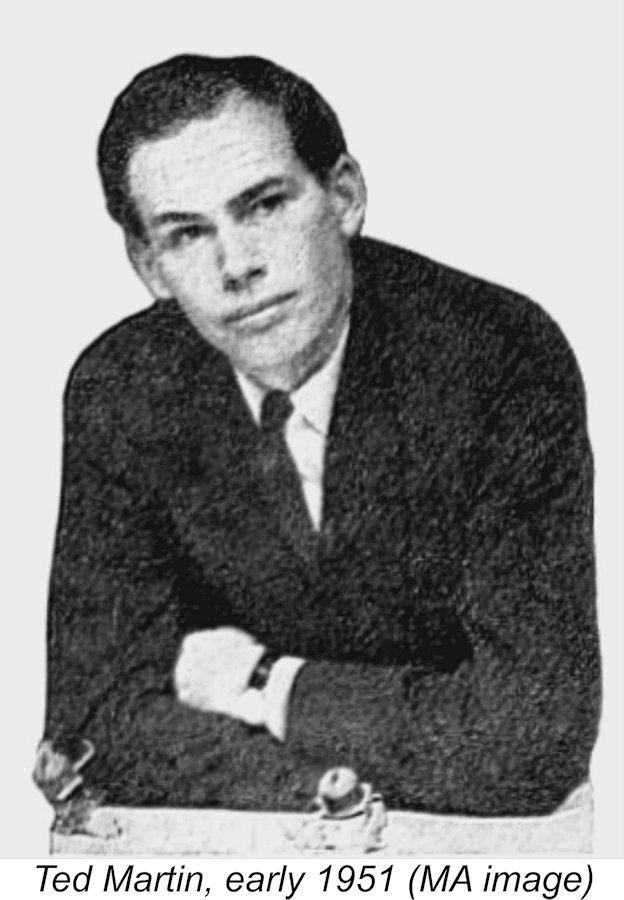 Finally, as a New Year’s bonus I’ve moved another of my biographical articles over from MEN to my own website. Regular readers will recall some of my earlier articles which trace the lives and work of certain notable personalities in the model engine world as opposed to focusing solely on the engines for which they were responsible. These include pieces covering the stories of such personalities as Ira Hassad, Alan Allbon, Basil Miles, George Court, Wilf Rowell, Dennis Allen, Giancarlo Pinotti, Jan David-Andersen, Gig Eifflaender, Col. H. J. Taplin, Ken Bedford and Hefin Davies, among others.
Finally, as a New Year’s bonus I’ve moved another of my biographical articles over from MEN to my own website. Regular readers will recall some of my earlier articles which trace the lives and work of certain notable personalities in the model engine world as opposed to focusing solely on the engines for which they were responsible. These include pieces covering the stories of such personalities as Ira Hassad, Alan Allbon, Basil Miles, George Court, Wilf Rowell, Dennis Allen, Giancarlo Pinotti, Jan David-Andersen, Gig Eifflaender, Col. H. J. Taplin, Ken Bedford and Hefin Davies, among others.
This month’s biographical piece covers the life and work of AMCO model engine designer E. C. (“Ted”) Martin. Although best known to the modelling fraternity for his work with the AMCO engines, Ted’s activities went far beyond model aero engine design, encompassing the fields of military aviation in WW2, full-sized racing cars, full-sized road-going vehicles and model live steam railroading. It’s a fascinating story of a mechanical engineering addict’s life lived to the full!
That’s about it for this month, fellow enthusiasts. All being well and assuming that my neighborhood remains free from the sound of tramping jackboots, roaring Abrams tank engines and M7 gunfire and that WW3 doesn’t engulf us all, I hope to return in February to present a few more reviews for your reading pleasure. In the meantime, I really appreciate all the expressions of support that I’ve continued to receive from so many of you! Stay safe!!
Adrian Duncan
British Columbia, Canada (the NATION, not a state!)
 ___________________________________
___________________________________
Note regarding material to be found on this site - unless specifically otherwise noted, all images and text which appear on this site are my own work, and I hereby assert my right to be recognized as the originator of this material except when expressly otherwise stated. For the record, this material is made freely available to all upon two firm conditions:
- No commercial use of any kind is to be made of any of the images or text posted on this site, in whole or in part, without my express written consent.
- No use of any kind, commercial or otherwise, is to be made of any material published in any form on this site, in whole or in part, without full and open acknowledgement of the source.

 Greetings once more to one and all! First, please allow me to express the hope that you’ve all enjoyed a rewarding holiday season with friends and family, and to extend my sincere wish to you all for as happy and prosperous a New Year as present circumstances permit. I hope that Santa was able to complete his rounds by visiting your area before Agent Orange (AO) was able to execute his plan to annex the North Pole, demolish the workshop to build a ballroom, turn the reindeer into steaks for his next Great Gatsby party and turn Santa, Mrs. Claus and the elves over to the tender mercies of ICE! The inmates appear to be running the asylum at present, and we can only hope for an eventual return to global sanity at some point down the road. Meanwhile, let’s all do our best to get the most of what life has to offer!
Greetings once more to one and all! First, please allow me to express the hope that you’ve all enjoyed a rewarding holiday season with friends and family, and to extend my sincere wish to you all for as happy and prosperous a New Year as present circumstances permit. I hope that Santa was able to complete his rounds by visiting your area before Agent Orange (AO) was able to execute his plan to annex the North Pole, demolish the workshop to build a ballroom, turn the reindeer into steaks for his next Great Gatsby party and turn Santa, Mrs. Claus and the elves over to the tender mercies of ICE! The inmates appear to be running the asylum at present, and we can only hope for an eventual return to global sanity at some point down the road. Meanwhile, let’s all do our best to get the most of what life has to offer! Next, the bad news! Down south, the incomprehensible election of a convicted felon, self-labeled ego-maniac, supporter of criminals, repeatedly-proven liar and enthusiastic associate of sex criminals to the Presidency continues to play out predictably through the process of steady erosion of the democratic rights and freedoms of the citizens of the US (seemingly with the inexplicable acquiescence of far too many of them) and the downgrading of the USA’s perceived status among the international community to the point where it’s no longer generally recognized as a “free democracy”, having been downgraded to a “flawed democracy” under the internationally-respected
Next, the bad news! Down south, the incomprehensible election of a convicted felon, self-labeled ego-maniac, supporter of criminals, repeatedly-proven liar and enthusiastic associate of sex criminals to the Presidency continues to play out predictably through the process of steady erosion of the democratic rights and freedoms of the citizens of the US (seemingly with the inexplicable acquiescence of far too many of them) and the downgrading of the USA’s perceived status among the international community to the point where it’s no longer generally recognized as a “free democracy”, having been downgraded to a “flawed democracy” under the internationally-respected  Agent Orange (AO) was elected to the office of President, but has yet to commence serving as such. He’s evidently too simple-minded to grasp the concept that to be the President, you have to act like the President, which among other things means serving the entire US population (not merely the MAGGATS) and advocating adherence to the Constitution rather than progressively ripping it up.
Agent Orange (AO) was elected to the office of President, but has yet to commence serving as such. He’s evidently too simple-minded to grasp the concept that to be the President, you have to act like the President, which among other things means serving the entire US population (not merely the MAGGATS) and advocating adherence to the Constitution rather than progressively ripping it up.  McCarthy era of the 1950’s, is nothing short of a gross invasion of privacy which together with his US Park user fees for visiting tourists will have the inevitable effect of further discouraging visitation to the USA, to the great detriment of the already hard-hit US tourism industry. His proposal to block any US State from enacting regulations governing the application of Artificial Intelligence (AI) demonstrates a frightening lack of understanding of the well-documented and very real threats to society which unrestricted AI unquestionably represents. His ongoing inane attempts to blame his predecessor for his own failures are becoming tiresome, even to some of his own supporters. Finally, his truly shameful (and barely coherent) comments on the deaths of Rob Reiner and his wife establish a new all-time low in terms of Presidential disrespect of the citizens of his own country whom he was elected to serve. So do his hate-filled 2025 “Christmas messages”……….
McCarthy era of the 1950’s, is nothing short of a gross invasion of privacy which together with his US Park user fees for visiting tourists will have the inevitable effect of further discouraging visitation to the USA, to the great detriment of the already hard-hit US tourism industry. His proposal to block any US State from enacting regulations governing the application of Artificial Intelligence (AI) demonstrates a frightening lack of understanding of the well-documented and very real threats to society which unrestricted AI unquestionably represents. His ongoing inane attempts to blame his predecessor for his own failures are becoming tiresome, even to some of his own supporters. Finally, his truly shameful (and barely coherent) comments on the deaths of Rob Reiner and his wife establish a new all-time low in terms of Presidential disrespect of the citizens of his own country whom he was elected to serve. So do his hate-filled 2025 “Christmas messages”……….  Among the more reprehensible actions undertaken recently by AO are his multiple seizures of oil tankers on the high seas and the statement that America will keep the oil. Whatever the reason for these actions, the outright theft of the oil from whoever owns it makes this piracy, pure and simple. Has he been watching “Treasure Island”, “Hook” or “Pirates of the Caribbean” - is he having Jack Sparrow delusions or something? Based on talent, Johnny Depp has nothing to worry about! Regardless, America is now a nation which officially endorses and profits from piracy on the high seas. Shameful …………….
Among the more reprehensible actions undertaken recently by AO are his multiple seizures of oil tankers on the high seas and the statement that America will keep the oil. Whatever the reason for these actions, the outright theft of the oil from whoever owns it makes this piracy, pure and simple. Has he been watching “Treasure Island”, “Hook” or “Pirates of the Caribbean” - is he having Jack Sparrow delusions or something? Based on talent, Johnny Depp has nothing to worry about! Regardless, America is now a nation which officially endorses and profits from piracy on the high seas. Shameful ……………. Looking on the bright side, AO has at least given us all our laugh for the month! His acceptance of the meaningless “Peace Prize” cobbled up by his buddy Gianni Infantino, the President of the world soccer governing body FIFA, exposes to one and all his immaturity, childish sense of insecurity and openness to flights of narcissistic fantasy. This “award” was created for AO simply because he was so vociferously upset at not being awarded a legitimate Peace Prize by the appropriate authorities despite his very active lobbying. When his juvenile tantrums came to the attention of his mate Gianni, the response was to assuage the child’s hurt feelings by creating an “award” especially for him – this from an organization whose business is supposedly soccer, not international diplomacy on a broader scale.
Looking on the bright side, AO has at least given us all our laugh for the month! His acceptance of the meaningless “Peace Prize” cobbled up by his buddy Gianni Infantino, the President of the world soccer governing body FIFA, exposes to one and all his immaturity, childish sense of insecurity and openness to flights of narcissistic fantasy. This “award” was created for AO simply because he was so vociferously upset at not being awarded a legitimate Peace Prize by the appropriate authorities despite his very active lobbying. When his juvenile tantrums came to the attention of his mate Gianni, the response was to assuage the child’s hurt feelings by creating an “award” especially for him – this from an organization whose business is supposedly soccer, not international diplomacy on a broader scale. AO’s acceptance of this “award” clearly implies that he actually sees it as legitimate, thus demonstrating once again his total lack of any sense of propriety or recognition of reality and making both AO and Infantino international laughing stocks – Infantino presenting a placebo for a baby’s dummy to Infantilo, which both see as being meaningful! I suppose that in one sense they are ………. the sight of the world’s most corrupt sporting organization honoring the world's most corrupt “official” does make a certain amount of sense, since the two go together like a proffered bribe bag and a grasping outstretched hand. Why would AO expect to win a real peace prize when he’s dedicated his political life to tearing his own country apart, conducting military occupations of American cities, preaching hate and division against the Democrats who represent half of the entire US population that he was elected to serve, indulging in piracy on the high seas, launching military strikes upon other countries with whom war has not been declared, supporting genocide in Gaza and threatening hitherto allied nations with unprovoked military annexation of part or all of their territory? Given these indisputable facts, what does he think that the FIFA “award” proves?!? Or does he think at all …..??
AO’s acceptance of this “award” clearly implies that he actually sees it as legitimate, thus demonstrating once again his total lack of any sense of propriety or recognition of reality and making both AO and Infantino international laughing stocks – Infantino presenting a placebo for a baby’s dummy to Infantilo, which both see as being meaningful! I suppose that in one sense they are ………. the sight of the world’s most corrupt sporting organization honoring the world's most corrupt “official” does make a certain amount of sense, since the two go together like a proffered bribe bag and a grasping outstretched hand. Why would AO expect to win a real peace prize when he’s dedicated his political life to tearing his own country apart, conducting military occupations of American cities, preaching hate and division against the Democrats who represent half of the entire US population that he was elected to serve, indulging in piracy on the high seas, launching military strikes upon other countries with whom war has not been declared, supporting genocide in Gaza and threatening hitherto allied nations with unprovoked military annexation of part or all of their territory? Given these indisputable facts, what does he think that the FIFA “award” proves?!? Or does he think at all …..?? Returning thankfully to reality, I’m always very pleased to hear from readers that they have found my articles to be interesting or useful. It’s that kind of feedback that keeps me going! However, my favourite reader reaction to my efforts is the provision of details and information sources which I’ve missed first time around.
Returning thankfully to reality, I’m always very pleased to hear from readers that they have found my articles to be interesting or useful. It’s that kind of feedback that keeps me going! However, my favourite reader reaction to my efforts is the provision of details and information sources which I’ve missed first time around. In this vein, the aforementioned Gordon Beeby of Australia has become one of my most active assistants, developing an uncanny knack for ferreting out obscure information sources relating to various articles. His latest tour de force is a search for information on the
In this vein, the aforementioned Gordon Beeby of Australia has become one of my most active assistants, developing an uncanny knack for ferreting out obscure information sources relating to various articles. His latest tour de force is a search for information on the  An unexpected but very welcome contact came from reader Tom Biesot of the Netherlands. In addition to being an engine collector who carries out his own restorations, Tom is also an amazingly accomplished precision woodworker. In that context, he sent some images of one of his latest creations - a complete model engine made entirely out of wood! Setting aside the materials used, this is a fully functional model engine! It is constructed from a variety of wood species, including beech, rosewood (dark), red alder (propellor), teak and ash. Think of it – wood lathes don’t have vernier top-slides or leadscrews: it’s all down to a steady hand! Tom put around 150 hours into the design and construction of this remarkable creation, which now graces his desktop! Amazing ..................
An unexpected but very welcome contact came from reader Tom Biesot of the Netherlands. In addition to being an engine collector who carries out his own restorations, Tom is also an amazingly accomplished precision woodworker. In that context, he sent some images of one of his latest creations - a complete model engine made entirely out of wood! Setting aside the materials used, this is a fully functional model engine! It is constructed from a variety of wood species, including beech, rosewood (dark), red alder (propellor), teak and ash. Think of it – wood lathes don’t have vernier top-slides or leadscrews: it’s all down to a steady hand! Tom put around 150 hours into the design and construction of this remarkable creation, which now graces his desktop! Amazing .................. Tom also sent me a Christmas card of his own creation. Although we’re now past Christmas, I thought that this card was far too nice not to share with you all! It displays Santa Cox in his sleigh drawn by his seven Cox reindeer! Note that Rudolph is a Tee-Deer!
Tom also sent me a Christmas card of his own creation. Although we’re now past Christmas, I thought that this card was far too nice not to share with you all! It displays Santa Cox in his sleigh drawn by his seven Cox reindeer! Note that Rudolph is a Tee-Deer! 

 OK, on to the new articles for this month! Despite the continuing pressures resulting from the highly charged international situation in which we find ourselves, I’ve somehow managed once again to assemble what I hope will be another interesting selection of articles for your reading pleasure. Moreover, I’ve had help!
OK, on to the new articles for this month! Despite the continuing pressures resulting from the highly charged international situation in which we find ourselves, I’ve somehow managed once again to assemble what I hope will be another interesting selection of articles for your reading pleasure. Moreover, I’ve had help! I already mentioned last month’s article about the pioneering
I already mentioned last month’s article about the pioneering  I mentioned earlier that I had help this time around. My good mate Maris Dislers has contributed an unsolicited review and test of the CS-manufactured 0.48 cc Clanford Clan diesel. Very informative! I’ve added this material to Maris’s existing article on the original
I mentioned earlier that I had help this time around. My good mate Maris Dislers has contributed an unsolicited review and test of the CS-manufactured 0.48 cc Clanford Clan diesel. Very informative! I’ve added this material to Maris’s existing article on the original  The MEN transfer article for the month deals with one of my own favourite facets of model engine design – the classic racing engine. This article deals with a very rare 10 cc model called the
The MEN transfer article for the month deals with one of my own favourite facets of model engine design – the classic racing engine. This article deals with a very rare 10 cc model called the  Finally, as a New Year’s bonus I’ve moved another of my biographical articles over from MEN to my own website. Regular readers will recall some of my earlier articles which trace the lives and work of certain notable personalities in the model engine world as opposed to focusing solely on the engines for which they were responsible. These include pieces covering the stories of such personalities as
Finally, as a New Year’s bonus I’ve moved another of my biographical articles over from MEN to my own website. Regular readers will recall some of my earlier articles which trace the lives and work of certain notable personalities in the model engine world as opposed to focusing solely on the engines for which they were responsible. These include pieces covering the stories of such personalities as  ___________________________________
___________________________________